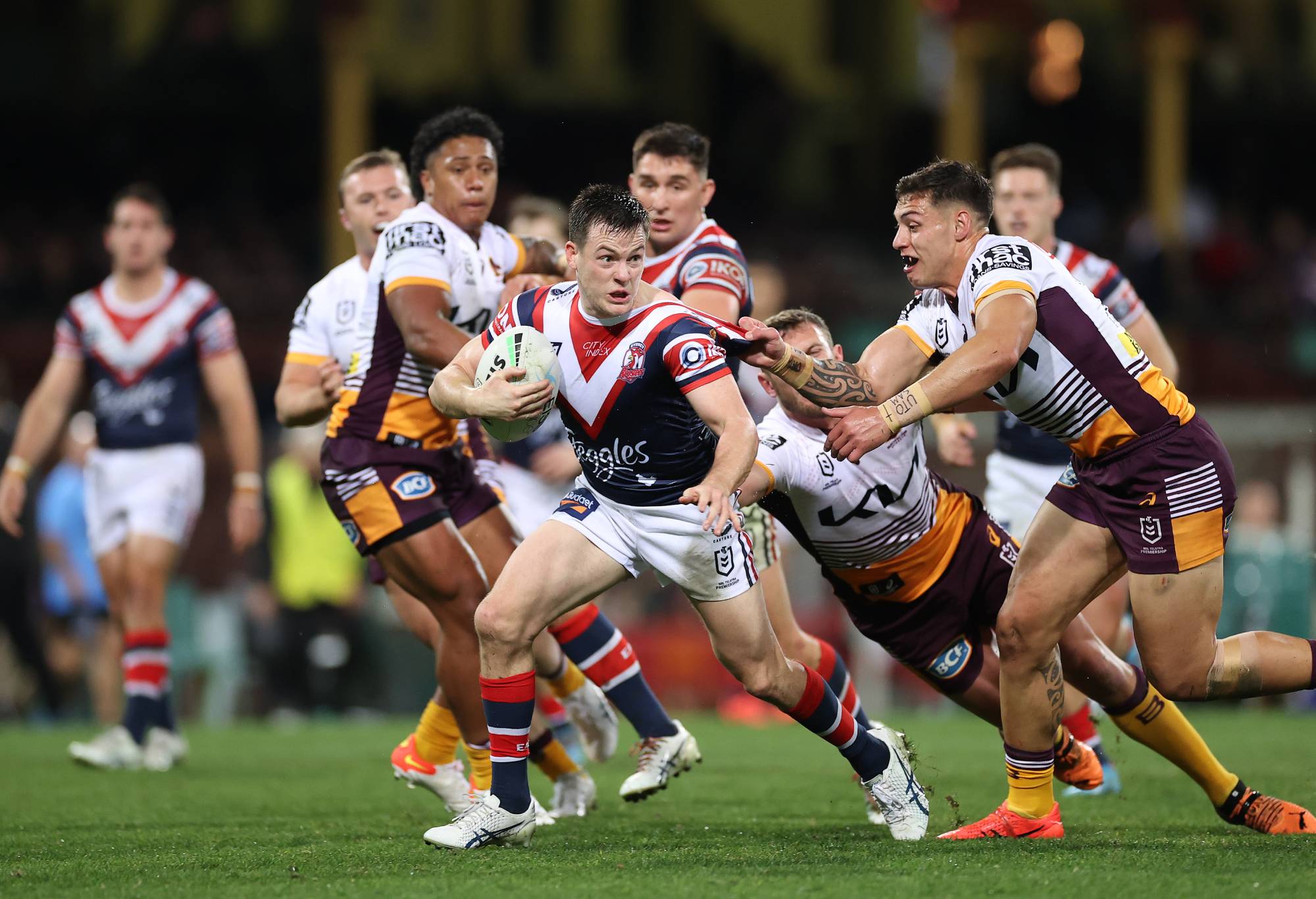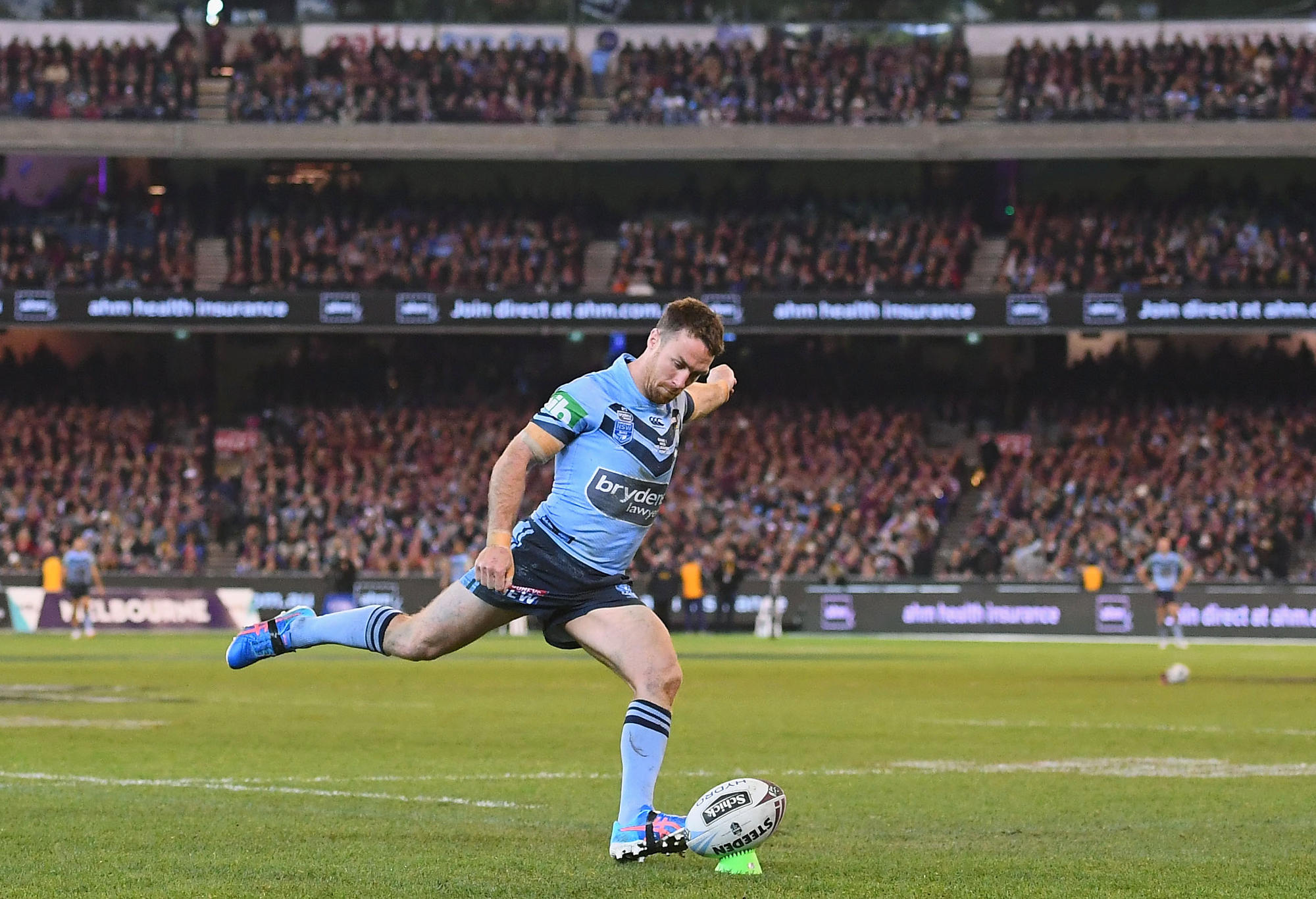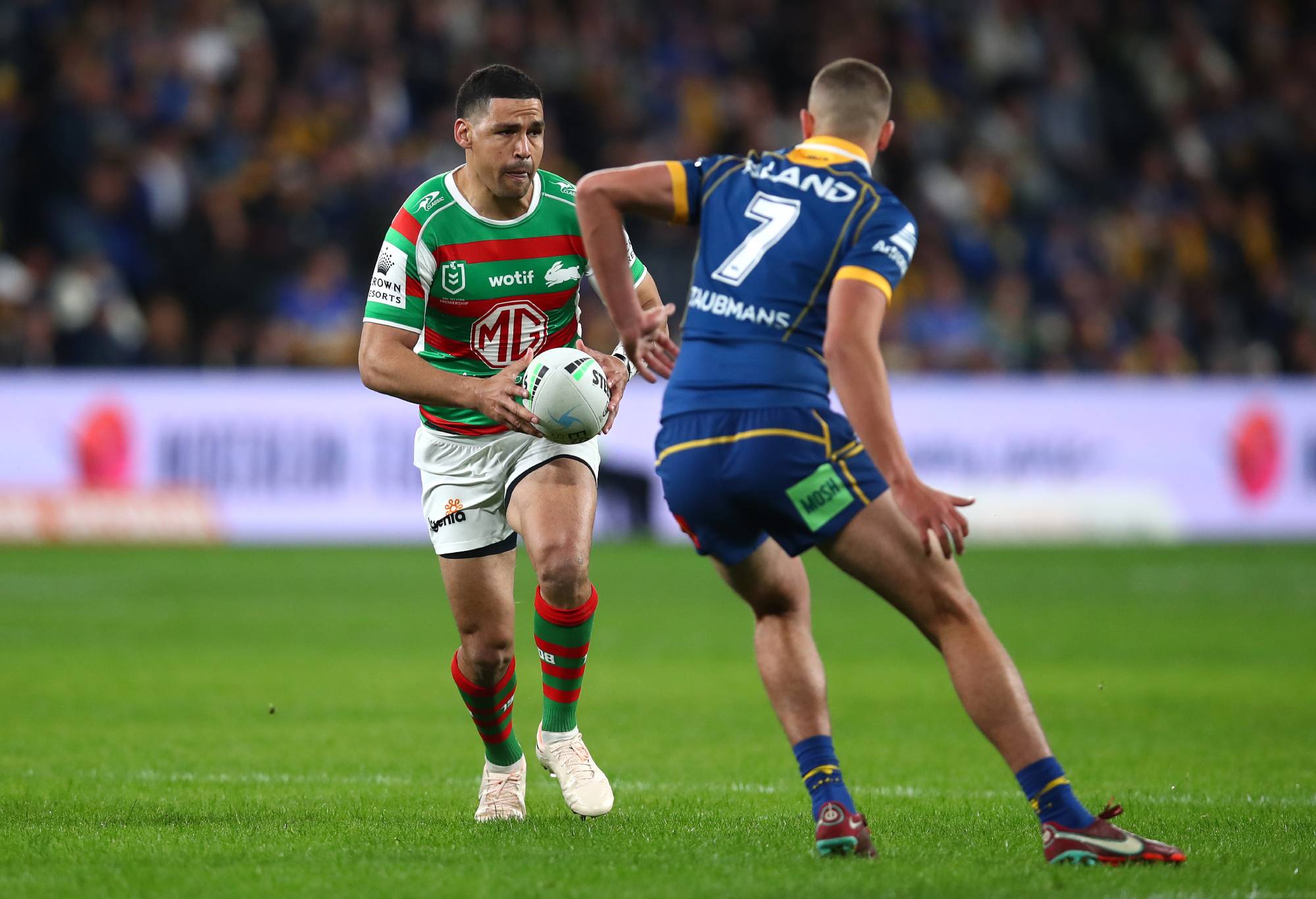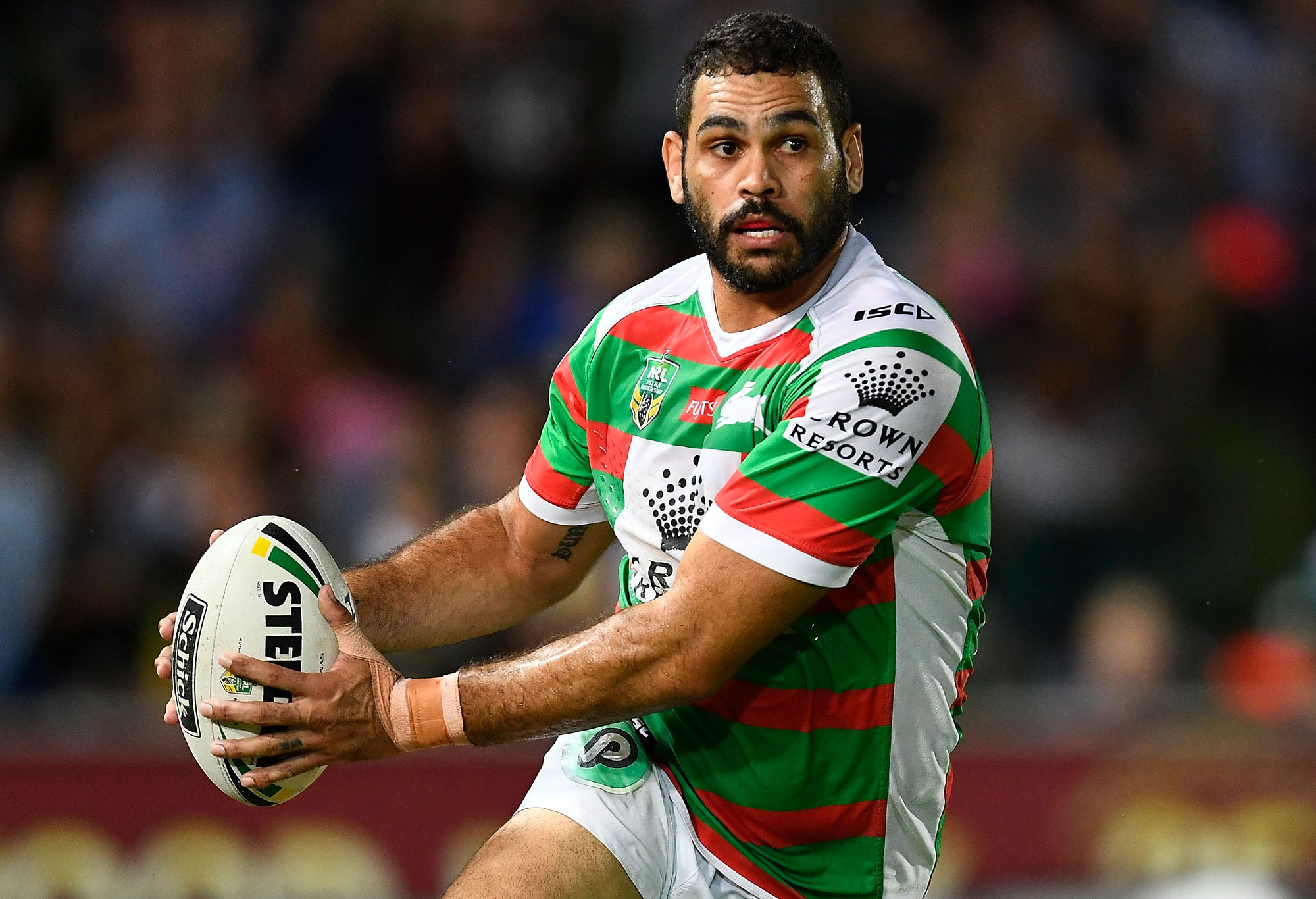The 25th season of the NRL is done and dusted so to commemorate the first quarter-century of this instalment of the premiership, The Roar is looking back at the 25 best players and moments in 25 categories.
We have already gone through the best fullbacks, wingers, locks, second-rowers,
players to never make Origin, coaches, captains, halfbacks, front-rowers,
goal-kickers, recruits, heaviest hitters, rookies and Grand Final moments of the era.
Next on the list is the pivotal position on the field – the five-eighths.
The secondary playmakers who step up when needed, the elusive runners who spark an attacking raid, the link between the halfback and the outside backs.

Brad Fittler in his days at the Roosters (Chris McGrath/ALLSPORT)
A good five-eighth is necessary in any team, the great ones make a massive difference on the scoreboard, as these 25 players certainly did throughout their careers.
Four players during the NRL era have won the Dally M Five-eighth of the Year award three times – Darren Lockyer, Brad Fittler, Cameron Munster and Johnathan Thurston.
Each player has been judged on their collective efforts from 1998 onwards, not including their efforts prior to that season, or if they’re an active player, up until 2022, without speculating on how their career might play out over next season and beyond.
CLICK HERE for a seven-day free trial to watch the NRL on KAYO
The top 10 – the best of the best
1 Darren Lockyer
2 Brad Fittler
3 Cameron Munster
4 Benji Marshall
5 Johnathan Thurston
6 Laurie Daley
7 Kieran Foran
8 Luke Keary
9 Jack Wighton
10 Trent Barrett
Lockyer played 165 of his 355 games for the Broncos at five-eighth, shifting from fullback permanently in 2004 when Karmichael Hunt came on the scene. The roles are similar but not everyone can make the transition and Lockyer did it with aplomb, guiding Brisbane to the 2006 premiership as the team’s chief playmaker. He also dominated in the five-eighth’s role for Queensland and Australia over the final eight years of his record-breaking career.

(Photo by Mark Nolan/Getty Images)
Fittler at the Roosters was different to young Freddie at the Panthers. He morphed into a leader while retaining the prodigious left-foot sidestep, ability to kick downfield with either foot and ability to break a game wide open, leading them to four grand finals in five years, crowned with the 2002 title.
Munster has the swagger that the great five-eighths of the past had, like Wally Lewis and Laurie Daley. With size and speed, he has shown at club, Origin and Test level he can conjure up attack out of nothing and now that his long-term future is sorted after signing a contract extension at the Storm, the 28-year-old is a future Hall of Famer.
Marshall in his first decade at the Wests Tigers, capped by the 2005 premiership, was unlike anything we’d seen as far as his magical leap then sidestep which left defenders constantly second-guessing themselves. His eight seasons after a brief switch to rugby were not dynamic but he ended his career eighth all time for games played with 346 as well as 31 Tests for the Kiwis.
Thurston only played 95 of his 323 NRL matches at five-eighths but managed to win three Dally M Five-eighth of the Year trophies during that time away from halfback. Whether he wore the No.6 or No.7 jersey for the Cowboys, Maroons or Kangaroos, he delivered a top-class playmaking performance, adapting his game to suit alongside the likes of Darren Lockyer and Cooper Cronk.
Daley, if we’re assessing his entire career, would clearly be much higher, challenging Lockyer for top spot but he only played three seasons in the NRL era before retiring in 2000 after persistent knee injuries. He was still performing at a high level for Canberra when he called it quits at the relatively young age of 30.
Foran is under-rated for the skill he brought to the table but his main strength was his competitive spirit. He was the ideal secondary playmaker for someone like Manly halfback Daly Cherry-Evans and despite injuries derailing his career in short stints at Parramatta, the Warriors and Canterbury, he’s still going strong at 32, earning a two-year deal at the Gold Coast to bring veteran leadership to the club.

(Photo by Cameron Spencer/Getty Images)
Keary has not been sighted much at representative level but his club record is one of the best in the past 10 years. He won a premiership with Souths in 2014 before collecting two more rings at the Roosters with his Clive Churchill Medal effort in the 2018 triumph one of the best individual performances in a Grand Final in many years.
Wighton is another converted fullback who follows the path of Lewis and Munster of being a powerful five-eighth whose greatest strength is his ability to break tackles on the fringe of the ruck to convert half chances into points. A worthy winner of the 2019 Clive Churchill Medal in Canberra’s losing effort and a surprise Dally M Medallist the following year, he is crucial to the Raiders’ chances of breaking their premiership drought in the near future.
Barrett was a teenage prodigy at the Steelers, forced into a switch to halfback when St George Illawarra merged to accommodate Anthony Mundine but then thrived when he returned to his favoured spot in 2000, going all the way to winning the Dally M Medal. His partnership with Andrew Johns at Origin level and occasionally in the Test side was superb.
Best of the rest – elite performers
11 Michael Morgan
12 Kevin Walters
13 Todd Carney
14 James Maloney
15 Jarome Luai
16 Preston Campbell
17 Gareth Widdop
18 Cody Walker
19 Braith Anasta
20 Jamie Soward
Morgan was one of the best utility players in recent times and like a lot of Mr Fix-Its, that was a blessing and a curse in that he played all over the field and off the bench initially at club and then in the Origin and Test arenas. Of his 168 NRL games, a career cut short by a shoulder injury, 74 were at five-eighth, including the 2015 Grand Final when his last-gasp flick pass set up Kyle Feldt’s try to force extra time in the Cowboys’ historic premiership win.
Walters is often not given due credit as he was seen as Allan Langer’s sidekick but his kicking and passing skills were up there with the best in the league in the 1990s until his retirement in 2001, captaining the Broncos to the 2000 title in Alfie’s No.7 jersey while his playmaking partner was in the Super League.
Carney was as skilful as any of these players but constantly brought his career off the rails with off-field stupidity, ultimately cutting his career short aged 28. A Dally M Medal winner during his finest individual season at the Roosters in 2010, he’s now a cautionary tale for all budding NRL stars that talent alone is not enough.

Is James Maloney’s career somewhat underrated? (Photo by Quinn Rooney/Getty Images)
Maloney didn’t get a start at Parramatta and didn’t get much game time at Melbourne but he then made a Grand Final during his stint at the Warriors, won a title at the Roosters and Sharks, and helped build the young Penrith side into a premiership force before finishing his career in the Super League.
Luai is one of the beneficiaries of Maloney’s time at Penrith, the ideal partner for star halfback Nathan Cleary. He’s yet to truly make his mark at Origin level but his performances for the Panthers and Samoa have been consistently dynamic.
Campbell was a Dally M Medal winner as a halfback at Cronulla but won a premiership at Penrith after being moved to five-eighth alongside Craig Gower. Fullback was probably his best spot but he ended up playing 105 of his 267 matches in the No.6 jersey, more than making up for his lack of size with his elusive darts all over the field.
Widdop’s best individual form was probably when he was at a mid-table Dragons side later in his career after the English playmaker had won a title in 2012 as part of Melbourne’s dominant side.
Walker was a late bloomer who did not make his first-grade debut until he was 26 but he has more than made up for lost time at the Rabbitohs and now has 169 NRL matches under his belt, including five straight playoff runs but the 2021 Grand Final loss is the closest he’s come to a premiership ring.

(Photo by Jason McCawley/Getty Images)
Anasta spent the best part of a decade as one of the NRL’s top five-eighths, initially with Canterbury – highlighted by the 2004 Grand Final triumph – and then with the Roosters where he led them from the wooden spoon to runners-up in 2010.
Soward was a multi-faceted attacking weapon who had pace off the mark, exceptional passing ability and one of the best kicking games in the NRL during his 215-game NRL career topped off by the 2010 premiership victory at St George Illawarra.
The final five
21 Scott Hill
22 Anthony Mundine
23 Greg Inglis
24 Matthew Johns
25 Anthony Milford
Hill played an even 200 NRL games but could have played a lot more if not for a run of injuries which cost him a spot in Melbourne’s 1999 Grand Final win. When he played at rep level, he always looked right at home in elite company and had the size to fill in at lock when needed.
Mundine is another player who had all the natural talent but it did not translate into a lengthy career. He became dismayed at representative snubs and retired to become a champion boxed in 2000 a month before his 25th birthday. But as far as attacking prowess goes, on his day he was as good as anyone on this list.
Inglis as a five-eighth is hard to gauge because he only played 48 matches in the position but did win a Clive Churchill Medal for his performance in the 2007 Grand Final, a victory for the Storm which was later declared null and void. He was that good he would have been elite in any position on a footy field.

Greg Inglis (Photo by Ian Hitchcock/Getty Images)
Johns is self-deprecating these days about his career but he was an extremely talented passer with a clever kicking game which meshed in well with his brother Andrew at the Knights.
Milford is another player with extraordinary talent but one who has lacked consistency over the course of his career which will be onto his fourth club when he trots out for the Dolphins in 2023.
Just missed the cut
Ben Ikin would have been ranked higher if not for serious knee injuries which cut short his career but he was still able to win a Grand Final at the Broncos in 2000.
Matt Moylan is in the Milford mould of plenty of talent but lacking reliability, particularly over his first few seasons at Cronulla.
Josh Reynolds was all heart and he extracted plenty out of his time in the NRL while Michael Buettner was another wholehearted performer whose efforts deserve not to be lost in the passage of time.
Canberra have had a couple of other pivots who strung together decent stints in Daley’s old No.6 jersey in Terry Campese and Blake Austin while young guns Matt Burton and Dylan Brown have the potential to become long-term representative players based on their first few years in the NRL.


































































































